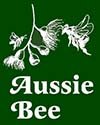FLOWERS LOVED BY AUSTRALIAN NATIVE BEES
Aussie Bee > Tips on Planting a Bee-Friendly Garden > Flowers Loved by Native Bees
Which plants should you choose for your Bee-Friendly Garden? We ran a survey in Aussie Bee Bulletin asking readers across Australia to nominate the favourite flowers loved by their local native bees. Here are ten of the top plants that were recommended:
Ten Favourite Flowers Loved by Australian Native Bees
Abelia x grandiflora -- Abelia
This medium shrub produces masses of white bell shaped flowers that are adored by Blue Banded Bees, Teddy Bear Bees, Carpenter Bees and many other species. It begins flowering in about December so it provides good nectar and pollen resources after many wildflowers finish flowering in spring.

The white flowers of the Abelia are a valuable resource during summer for native bees.
Buddleja -- Butterfly Bush
This tall shrub produces clusters of flowers that are enjoyed by many types of native bees. Leafcutter Bees also enthusiastically cut discs from the soft leaves for nesting material. Reed Bees too will nest in the pithy canes of the Buddleja.
This plant provides great resources for a wide range of native bees. However, please note that Buddleja can act as an environmental weed in damp sclerophyll forest, disturbed areas, roadsides and river beds, especially in Victoria and South Australia. We have not had any problem with this plant in our rather dry area, but please do not use it if it may cause a weed problem in your area.

Blue Banded Bees love the small flowers of the Butterfly Bush and Leafcutter Bees love to cut disks from its soft leaves for their nest materials (see arrow).
Callistemon -- Bottlebrush
The abundant bright red flowers of the bottlebrush are attractive to a wide range of native bee species and nectar-feeding birds. These hardy small to large shrubs can be used as ground covers, hedges, screening shrubs or street trees.

Native Bottlebrush shrubs produce a mass of nectar and pollen rich flowers that native bees and birds love.
Daisies -- many varieties
The shallow flowers of daisies provide readily accessible nectar and pollen to all native bee species. Flowering for long periods, these compact low-growing shrubs could find a place in even the smallest garden. Both native species (e.g. the Cut Leaf Daisy Brachyscome and the Everlasting Daisy Bracteantha) and exotic species (e.g. the African Daisy Osteospermum and the Seaside Daisy Erigeron) are popular with native bees.

Daisies of many types produce abundant flowers over a long period -- and their nectar can be easily reached by both short tongued and long tongued native bees.
Eucalyptus and Angophora -- Gum Trees
The prolific flowers produced by these trees are highly attractive to a wide range of native bee species. In fact, when gum trees are in flower nearby, we find that few native bees may be seen on other shrubs in our bee-friendly garden. Mature trees are also an important source of resin for Stingless Bees and Resin Bees. A disadvantage of some species is that they may not flower every year.

When native gum trees flower, their branches are laden with dense blossoms that attract many kinds of bees.
Grevillea -- Spider Flower
Grevillea hybrids are long flowering shrubs that produce large amounts of nectar. They attract a wide range of native bees, as well as nectar-feeding birds. They range in size from tall shrubs to prostrate varieties to suit many different garden situations.

Stingless bees are enthusiastically collecting the copious nectar from this Royal Mantle Grevillea flower. This prostrate Grevillea variety spreads up to 6m wide, providing a wealth of native flowers for our local bees.
Lavandula -- Lavender
The purple flower spikes of the lavender are particulary attractive to Blue Banded Bees. These are compact hardy shrubs that produce plenty of nectar and flower for a long period. Other herbs in this family, such as basil, thyme, lemon balm and mint are also very popular with native bees.

These purple Lavender flowers are sure to attract any Blue Banded Bees in your area.
Leptospermum -- Tea Tree
Native bees as well as many other wild pollinators will flock to the cup-shaped flowers of tea trees. With papery layered bark, tea trees range in size from small trees to prostrate shrubs.

The dense white flowers of the native Tea Tree will attract and support a wide range of native pollinators.
Melaleuca -- Honey Myrtle
The abundant brush-like flowers of the Melaleuca attract numerous native bees as well as birds. Different varieties range in size from small shrubs to small trees.

A native Melaleuca shrub or hedge will provide copious blossom to support native pollinators.
Westringia -- Native Rosemary
These hardy shrubs flower almost all year round and are particularly attractive to Blue Banded Bees and Teddy Bear Bees.

The native Westringia attracts and supports long tongued bees such as Blue Banded Bees and Teddy Bear Bees over a long period.
For More Detailed Recommendations...
The best flower species to choose for your bee-friendly garden depends on where you live in Australia and what your local climate is like. For more ideas, download this free 330 page guide by Mark Leech of the Australian Government RIRDC: Bee Friendly - A Planting Guide for European Honeybees and Australian Native Pollinators.
Read Aussie Bee's Tips on Setting Up a Bee-Friendly Garden.
And why not set up some Bee Hotels to provide nesting sites for your local solitary bees too? Read Aussie Bee's Guide to Setting Up a Bee Hotel.



